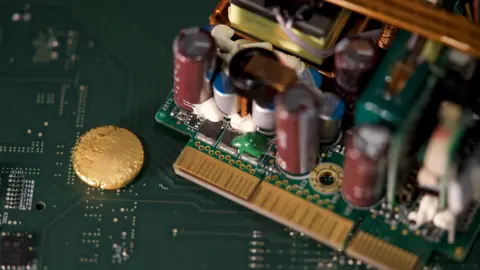 BBC/Kevin Church
BBC/Kevin ChurchThe company has built a large industrial plant on its site in Llantrisant in Wales to remove the precious metal from old circuit boards.
The gold is initially being used to craft jewellery and later it will be made into commemorative coins.
E-waste, which includes anything from old phones and computers to TVs, is a rapidly growing problem – the UN says 62m tonnes were thrown away in 2022.
Its latest report estimates that the mountain of discarded tech is set to increase by about a third by 2030.
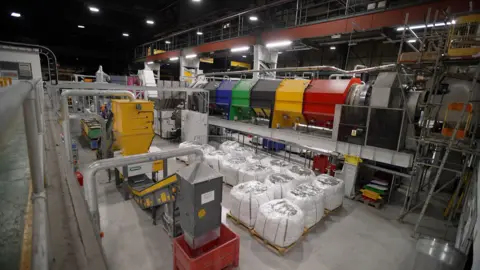 BBC/Kevin Church
BBC/Kevin ChurchAt the Royal Mint plant, piles of circuit boards are being fed into the new facility.
First, they are heated to remove their various components. Then the array of detached coils, capacitors, pins and transistors are sieved, sorted, sliced and diced as they move along a conveyor belt.
Anything with gold in it is set aside.
“What we’re doing here is urban mining,” says head of sustainability Inga Doak.
“We’re taking a waste product that’s being produced by society and we’re mining the gold from that waste product and starting to see the value in that finite resource.”
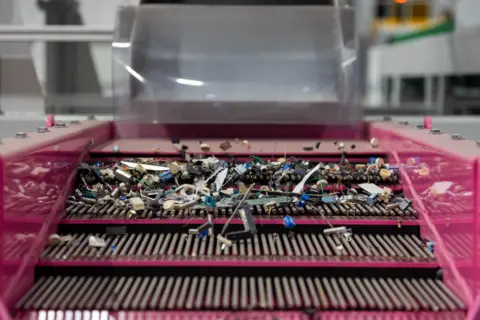 Royal Mint
Royal MintThe gold-laden pieces go to an on-site chemical plant.
They’re tipped into a chemical solution which leeches the gold out into the liquid.
This is then filtered, leaving a powder behind. It looks pretty nondescript but this is actually pure gold – it just needs to be heated in a furnace to be transformed into a gleaming nugget.
“Traditional gold recovery processes are very energy intensive and use very toxic chemicals that can only be used once, or they go to high energy smelters and they’re basically burnt,” says Leighton John, the Royal Mint’s operations director.
“The ground-breaking thing for us is the fact that this chemistry is used at room temperature, at very low energy, it’s recyclable and pulls gold really quickly.”
There’s no shortage of e-waste for the Royal Mint to target. The UN’s 2024 e-waste report places the UK as the second biggest producer of tech trash per capita, beaten only by Norway.
“Our aim is to process over 4,000 tonnes of e-waste annually,” says Leighton John.
“Traditionally this waste is shipped overseas but we’re keeping it in the UK and we’re keeping those elements in the UK for us to use. It’s really important.”
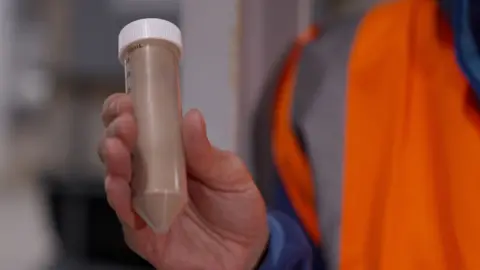 BBC/Kevin Church
BBC/Kevin ChurchFour thousand tonnes of e-waste should generate up to 450kg of gold, which is worth about £27m at current prices.
This shift into the waste business is a big change for the Royal Mint.
For more than a thousand years, it has been the UK’s official coin maker.
But with cash use dwindling, e-waste is a new way for the government-owned company to make money – and save jobs.
“We needed to diversify,” explains CEO Anne Jessopp.
“And given that less people are now needed to make coins, actually it was an ideal opportunity to move people across [to e-waste processing] so that we could keep jobs for those people.”
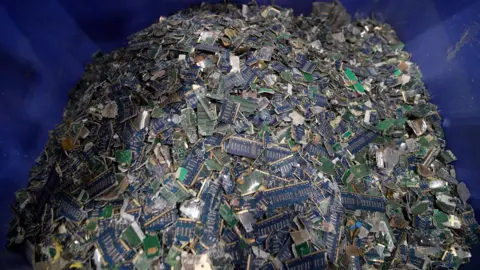 BBC/Kevin Church
BBC/Kevin ChurchAs well as recovering gold, the company is also looking at what to do with all of the other materials that it is separating out from the circuit boards.
They contain a number of different materials including aluminium, copper, tin and steel. They’re also investigating whether ground up boards could be used by the construction industry.

